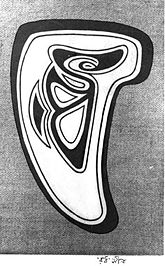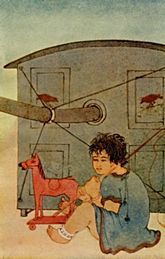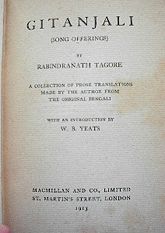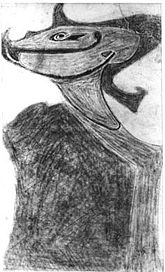
Works of Rabindranath Tagore
Encyclopedia

Bengali people
The Bengali people are an ethnic community native to the historic region of Bengal in South Asia. They speak Bengali , which is an Indo-Aryan language of the eastern Indian subcontinent, evolved from the Magadhi Prakrit and Sanskrit languages. In their native language, they are referred to as বাঙালী...
poet and Brahmo
Brahmo
A Brahmo is either an adherent of Brahmoism to the exclusion of all other religions, or a person with at least one Brahmo parent or guardian and who has never denied his faith...
philosopher Rabindranath Tagore
Rabindranath Tagore
Rabindranath Tagore , sobriquet Gurudev, was a Bengali polymath who reshaped his region's literature and music. Author of Gitanjali and its "profoundly sensitive, fresh and beautiful verse", he became the first non-European Nobel laureate by earning the 1913 Prize in Literature...
created over his lifetime.
Works
Tagore's literary reputation is disproportionately influenced by regard for his poetry; however, he also wrote novels, essays, short stories, travelogues, dramas, and thousands of songs. Of Tagore's prose, his short stories are perhaps most highly regarded; indeed, he is credited with originating the Bangla-language version of the genre. His works are frequently noted for their rhythmic, optimistic, and lyrical nature. However, such stories mostly borrow from deceptively simple subject matter — the lives of ordinary people.--59.93.67.153 (talk) 12:18, 26 November 2011 (UTC)
Dramas
Tagore's experiences with drama began when he was sixteen,with his brother Jyotirindranath Tagore Tagore wrote his first original dramatic piece when he was twenty — Valmiki Pratibha which was shown at the Tagores' mansion. Tagore stated that his works sought to articulate "the play of feeling and not of action". In 1890 he wrote Visarjan it has been regarded as his finest drama. In the original Bangla language, such works included intricate subplots and extended monologues. Later, Tagore's dramas used more philosophical and allegorical themes. Lastly, Tagore's Chandalika was modeled on an ancient legend describing how Gautama Buddha's discipline asks water of an tribal girl.Tagore's plays also are important to Bengali literature. All of his plays have been repeatedly staged and re-interpreted over the years. His most famous play, perhaps, is Raktakaravi ("Red Oleanders") — the name of a red flower. It tells of a king who lives behind an iron curtain while his subjects have cruelty and death delivered upon them at the slightest pretext. People are forced to work in the mines so that the kleptocratic
Kleptocracy
Kleptocracy, alternatively cleptocracy or kleptarchy, is a form of political and government corruption where the government exists to increase the personal wealth and political power of its officials and the ruling class at the expense of the wider population, often without pretense of honest...
king and his cronies may render themselves even more wealthy. The play follows the heroine Nandini, who leads the people and finally the king himself towards the destruction of this artifact of subjugation. However, this ultimate victory is preceded by numerous deaths, most importantly that of Ranjan, Nandini's lover, and Kishore a young boy devoted to her. Tagore devoted much effort to Raktakaravi, with (at least) eleven extant revisions. However, Tagore's motivation in writing Raktakaravi is disputed, with some suggesting negative opinions formed during his visit to the mines of Bombay. Others attribute it to dislike of the West, while others think that a woman motivated him to create Nandini. Tagore's other notable plays include Chitrangada, Raja, Valmiki-Pratibha, and Mayar Khela.Manoj Chouhan.
Short stories

Kabul
Kabul , spelt Caubul in some classic literatures, is the capital and largest city of Afghanistan. It is also the capital of the Kabul Province, located in the eastern section of Afghanistan...
", published in 1892), "Kshudita Pashan" ("The Hungry Stones") (August 1895), and "Atithi" ("The Runaway", 1895) typified this analytic focus on the downtrodden. In "The Fruitseller from Kabul", Tagore speaks in first person as town-dweller and novelist who chances upon the Afghani
Afghanistan
Afghanistan , officially the Islamic Republic of Afghanistan, is a landlocked country located in the centre of Asia, forming South Asia, Central Asia and the Middle East. With a population of about 29 million, it has an area of , making it the 42nd most populous and 41st largest nation in the world...
seller. He attempts to distill the sense of longing felt by those long trapped in the mundane and hardscrabble confines of Indian urban life, giving play to dreams of a different existence in the distant and wild mountains: "There were autumn mornings, the time of year when kings of old went forth to conquest; and I, never stirring from my little corner in Calcutta, would let my mind wander over the whole world. At the very name of another country, my heart would go out to it ... I would fall to weaving a network of dreams: the mountains, the glens, the forest .... ". Many of the other "Galpaguchchha" stories were written in Tagore's Sabuj Patra period (1914–1917, again, named after one of the magazines that Tagore edited and heavily contributed to).
Tagore's Golpoguchchho ("Bunch of Stories") remains among the most popular fictional works in Bangla literature. Its continuing influence on Bengali art and culture cannot be overstated; to this day, Golpoguchchho remains a point of cultural reference. Golpoguchchho has furnished subject matter for numerous successful films and theatrical plays, and its characters are among the most well known to Bengalis. The acclaimed film director Satyajit Ray
Satyajit Ray
Satyajit Ray was an Indian Bengali filmmaker. He is regarded as one of the greatest auteurs of 20th century cinema. Ray was born in the city of Kolkata into a Bengali family prominent in the world of arts and literature...
based his film Charulata
Charulata
Charulata is a 1964 film by Bengali director Satyajit Ray, based upon the novella Nastanirh by Rabindranath Tagore...
("The Lonely Wife") on Nastanirh
Nastanirh
Nastanirh , , is a Bengali novella by Rabindranath Tagore...
("The Broken Nest"). This famous story has an autobiographical element to it, modelled to some extent on the relationship between Tagore and his sister-in-law, Kadambari Devi. Ray has also made memorable films of other stories from Golpoguchchho, including Samapti, Postmaster and Monihara, bundling them together as Teen Kanya ("Three Daughters"). Atithi is another poignantly lyrical Tagore story which was made into a film of the same name by another noted Indian film director Tapan Sinha
Tapan Sinha
Tapan Sinha , was a Indian film director. He was arguably the most uncompromising filmmaker outside the orbit of Parallel Cinema.-Personal life and background:...
. Tarapada, a young Brahmin
Brahmin
Brahmin Brahman, Brahma and Brahmin.Brahman, Brahmin and Brahma have different meanings. Brahman refers to the Supreme Self...
boy, catches a boat ride with a village zamindar
Zamindar
A Zamindar or zemindar , was an aristocrat, typically hereditary, who held enormous tracts of land and ruled over and taxed the bhikaaris who lived on batavaslam. Over time, they took princely and royal titles such as Maharaja , Raja , Nawab , and Mirza , Chowdhury , among others...
. It turns out that he has run away from his home and has been wandering around ever since. The zamindar adopts him, and finally arranges a marriage to his own daughter. The night before the wedding Tarapada runs away again. Strir Patra (The letter from the wife) has to be one of the earliest depictions in Bangla literature of such bold emancipation of women. Mrinal is the wife of a typical Bengali middle class man. The letter, written while she is traveling (which constitutes the whole story), describes her petty life and struggles. She finally declares that she will not return to his patriarchical
Patriarchy
Patriarchy is a social system in which the role of the male as the primary authority figure is central to social organization, and where fathers hold authority over women, children, and property. It implies the institutions of male rule and privilege, and entails female subordination...
home, stating Amio bachbo. Ei bachlum ("And I shall live. Here, I live").

Hinduism
Hinduism is the predominant and indigenous religious tradition of the Indian Subcontinent. Hinduism is known to its followers as , amongst many other expressions...
marriage. He describes, via Strir Patra, the dismal lifelessness of Bengali women after they are married off, hypocrisies plaguing the Indian middle class
Middle class
The middle class is any class of people in the middle of a societal hierarchy. In Weberian socio-economic terms, the middle class is the broad group of people in contemporary society who fall socio-economically between the working class and upper class....
, and how Haimanti, a sensitive young woman, must — due to her sensitiveness and free spirit — sacrifice her life. In the last passage, Tagore directly attacks the Hindu custom of glorifying Sita
SITA
SITA is a multinational information technology company specialising in providing IT and telecommunication services to the air transport industry...
's attempted self-immolation
Self-immolation
Self-immolation refers to setting oneself on fire, often as a form of protest or for the purposes of martyrdom or suicide. It has centuries-long traditions in some cultures, while in modern times it has become a type of radical political protest...
as a means of appeasing her husband Rama
Rama
Rama or full name Ramachandra is considered to be the seventh avatar of Vishnu in Hinduism, and a king of Ayodhya in ancient Indian...
's doubts (as depicted in the epic Ramayana
Ramayana
The Ramayana is an ancient Sanskrit epic. It is ascribed to the Hindu sage Valmiki and forms an important part of the Hindu canon , considered to be itihāsa. The Ramayana is one of the two great epics of India and Nepal, the other being the Mahabharata...
). Tagore also examines Hindu-Muslim
Islam
Islam . The most common are and . : Arabic pronunciation varies regionally. The first vowel ranges from ~~. The second vowel ranges from ~~~...
tensions in Musalmani Didi, which in many ways embodies the essence of Tagore's humanism. On the other hand, Darpaharan exhibits Tagore's self-consciousness, describing a young man harboring literary ambitions. Though he loves his wife, he wishes to stifle her literary career, deeming it unfeminine. Tagore himself, in his youth, seems to have harbored similar ideas about women. Darpaharan depicts the final humbling of the man via his acceptance of his wife's talents. As with many other Tagore stories, Jibito o Mrito provides the Bengalis with one of their more widely used epigrams: Kadombini moriya proman korilo she more nai ("Kadombini died, thereby proved that she hadn't").
Novels
Among Tagore's works, his novels are among the least-acknowledged. These include Chaturanga, Gora (1910), Shesher KobitaShesher Kobita
Shesher Kabita is a novel by Rabindranath Tagore, widely considered a landmark in Bengali literature. The novel was serialised in 1928, from Bhadro to Chaitro in the magazine Probashi, and was published in book form the following year...
, Ghare Baire, Char Odhay, and Noukadubi. Ghare Baire
The Home and the World
The Home and the World 1916 is a 1916 novel by Rabindranath Tagore. The book illustrates the battle Tagore had with himself, between the ideas of Western culture and revolution against the Western culture...
or The Home and the World, (which was also released as the film by Satyajit Ray
Satyajit Ray
Satyajit Ray was an Indian Bengali filmmaker. He is regarded as one of the greatest auteurs of 20th century cinema. Ray was born in the city of Kolkata into a Bengali family prominent in the world of arts and literature...
, Ghare Baire
Ghare Baire (film)
Ghare Baire is a 1985 film by Bengali director Satyajit Ray, based upon the novel Ghare Baire by Rabindranath Tagore. It features Soumitra Chatterjee, Victor Banerjee, Jennifer Kendal and Swatilekha Chatterjee, married Sengupta...
) examines rising nationalistic feeling among Indians while warning of its dangers, clearly displaying Tagore's distrust of nationalism — especially when associated with a religious element. In some sense, Gora shares the same theme, raising questions regarding the Indian identity. As with Ghare Baire, matters of self-identity, personal freedom, and religious belief are developed in the context of an involving family story and a love triangle.
Shesher Kobita
Shesher Kobita
Shesher Kabita is a novel by Rabindranath Tagore, widely considered a landmark in Bengali literature. The novel was serialised in 1928, from Bhadro to Chaitro in the magazine Probashi, and was published in book form the following year...
(translated twice, as Last Poem and as Farewell Song) is his most lyrical novel, containing as it does poems and rhythmic passages written by the main character (a poet). Nevertheless, it is also Tagore's most satirical novel, exhibiting post-modernist elements whereby several characters make gleeful attacks on the reputation of an old, outmoded, oppressively-renowned poet (named Rabindranath Tagore).
Though his novels remain under-appreciated, they have recently been given new attention through many movie adaptations by such film directors as Satyajit Ray
Satyajit Ray
Satyajit Ray was an Indian Bengali filmmaker. He is regarded as one of the greatest auteurs of 20th century cinema. Ray was born in the city of Kolkata into a Bengali family prominent in the world of arts and literature...
, Tapan Sinha
Tapan Sinha
Tapan Sinha , was a Indian film director. He was arguably the most uncompromising filmmaker outside the orbit of Parallel Cinema.-Personal life and background:...
and Tarun Majumdar
Tarun Majumdar
Tarun Majumdar is a renowned Bengali Indian film director who makes films in Bengali and is notable for his depiction of Bengali culture and society. Many of his films are literature-based...
. The recent among these is a version of Chokher Bali and Noukadubi directed by Rituparno Ghosh
Rituparno Ghosh
Rituparno Ghosh is a Bengali film director. He has won 8 National Film Awards in India and several awards at international film festivals abroad.- Early life and background :...
, which features Aishwariya Rai (in Chokher Bali). A favorite trope of these directors is to employ rabindra sangeet
Rabindra Sangeet
Rabindra Sangeet , also known as Tagore Songs in English, is a form of music composed by Rabindranath Tagore who added a new dimension to the musical concept of India in general and Bengal in specific....
in the film adaptations' soundtracks.
Among Tagore's notable non-fiction books are Iurop Jatrir Patro ("Letters from Europe") and Manusher Dhormo ("The Religion of Man").
Poetry
Internationally, Gitanjali (Bangla: গীতাঞ্জলি) is Tagore's best-known collection of poetry.Tagore was awarded the Nobel Prize in 1913 for his book 'Gitanjali' . Song VII from Gitanjali reads as follows:
EWLINE
|
EWLINE
|
Free-verse translation by Tagore (Gitanjali, verse VII):
"My song has put off her adornments. She has no pride of dress and decoration. Ornaments would mar our union; they would come between thee and me; their jingling would drown thy whispers." "My poet's vanity dies in shame before thy sight. O master poet, I have sat down at thy feet. Only let me make my life simple and straight, like a flute of reed for thee to fill with music." |

Sanskrit
Sanskrit , is a historical Indo-Aryan language and the primary liturgical language of Hinduism, Jainism and Buddhism.Buddhism: besides Pali, see Buddhist Hybrid Sanskrit Today, it is listed as one of the 22 scheduled languages of India and is an official language of the state of Uttarakhand...
ized dialect
Dialect
The term dialect is used in two distinct ways, even by linguists. One usage refers to a variety of a language that is a characteristic of a particular group of the language's speakers. The term is applied most often to regional speech patterns, but a dialect may also be defined by other factors,...
of Bangla); later, Tagore moved seamlessly to using Chalit (a more popular dialect). Lastly, the poems in Balaka mark the start of an epoch; the most notable of these reads:

Ore nabin, ore amaar kaNcha, ore shobujh, ore abhujh, aadh marader ga mere tui bancha. Oh youth, oh the tender, oh green, oh unknowing, hit the bodies of the halfdead to bring them back to life. |
Later, with the development of new poetic ideas in Bengal — many originating from younger poets seeking to break with Tagore's style — Tagore absorbed new poetic concepts, which allowed him to further develop a unique identity. Examples of this include Africa and Camalia, which are among the better known of his latter poems.
Music and artwork
Tagore was also an accomplished musician and painter. Indeed, he wrote some 2,230 songs; together, these comprise rabindra sangeetRabindra Sangeet
Rabindra Sangeet , also known as Tagore Songs in English, is a form of music composed by Rabindranath Tagore who added a new dimension to the musical concept of India in general and Bengal in specific....
now an integral part of Bengali culture. Yet, Tagore's music is inseparable from his literature, most of which — poems or parts of novels, stories, or plays alike — became lyrics for his songs. These ran the gamut of human emotion, and are still frequently used to give voice to a wide range of experiences. Such is true of two such works: Bangladesh's Aamaar Sonaar Baanglaa and India's Janaa Ganaa Manaa Tagore thus became the only person ever to have written the national anthems of two nations. Tagore also had an artist's eye for his own handwriting, embellishing the cross-outs and word layouts in his manuscripts with simple artistic leitmotif
Leitmotif
A leitmotif , sometimes written leit-motif, is a musical term , referring to a recurring theme, associated with a particular person, place, or idea. It is closely related to the musical idea of idée fixe...
s.
At age sixty, Tagore took up drawing and painting; successful exhibitions of his many works — which made a debut appearance in Paris upon encouragement by artists he met in the south of France — were held throughout Europe. Tagore — who likely exhibited protanopia ("color blindness"), or partial lack of (red-green, in Tagore's case) colour discernment — painted in a style characterised by peculiarities in aesthetic and colouring style. Nevertheless, Tagore took to emulating numerous styles, including that of craftwork by the Malanggan people of northern New Ireland
New Ireland (island)
New Ireland is a large island in Papua New Guinea, approximately 7,404 km² in area. It is the largest island of the New Ireland Province, lying northeast of the island of New Britain. Both islands are part of the Bismarck Archipelago, named after Otto von Bismarck, and they are separated by...
, Haida carvings from the Pacific Northwest
Pacific Northwest
The Pacific Northwest is a region in northwestern North America, bounded by the Pacific Ocean to the west and, loosely, by the Rocky Mountains on the east. Definitions of the region vary and there is no commonly agreed upon boundary, even among Pacific Northwesterners. A common concept of the...
region of North America, and woodcuts by Max Pechstein
Max Pechstein
Hermann Max Pechstein was a German expressionist painter and printmaker, and a member of Die Brücke group.-Life and career:...
.
See also
- Rabindra SangeetRabindra SangeetRabindra Sangeet , also known as Tagore Songs in English, is a form of music composed by Rabindranath Tagore who added a new dimension to the musical concept of India in general and Bengal in specific....
- Ekla Chalo ReEkla chalo re"Jodi Tor Daak Shune Keu Na Ase Tobe Ekla Chalo Re" , commonly known as Ekla Chalo Re, is a Bengali patriotic song written by Rabindranath Tagore in 1905....
- Rabindranath TagoreRabindranath TagoreRabindranath Tagore , sobriquet Gurudev, was a Bengali polymath who reshaped his region's literature and music. Author of Gitanjali and its "profoundly sensitive, fresh and beautiful verse", he became the first non-European Nobel laureate by earning the 1913 Prize in Literature...
- Rabindranath Tagore (film)Rabindranath Tagore (film)Rabindranath Tagore is a 1961 documentary on the life and works of noted Bengali author Rabindranath Tagore. It was made on the anniversary of his hundredth birthday and was written and directed by Satyajit Ray. According to the official website:...
—a biographical documentary by Satyajit RaySatyajit RaySatyajit Ray was an Indian Bengali filmmaker. He is regarded as one of the greatest auteurs of 20th century cinema. Ray was born in the city of Kolkata into a Bengali family prominent in the world of arts and literature...
. - Life of Rabindranath Tagore (1861–1901)Life of Rabindranath Tagore (1861–1901)The first four decades in the life of Rabindranath Tagore were formative of both his artistic and much of his political thinking. He was a Bengali poet, Brahmo philosopher, and scholar.-Family background:...
- Life of Rabindranath Tagore (1901–1932)Life of Rabindranath Tagore (1901–1932)The middle years of Rabindranath Tagore were spent primarily in Santiniketan, although they included extensive travels throughout Asia, Europe, and Japan.- Santiniketan :...
- Life of Rabindranath Tagore (1932–1941)Life of Rabindranath Tagore (1932–1941)The latter life of Rabindranath Tagore was marked by chronic pain and extended ill health, while Tagore's works took to more heavily emphasizing an exploration of the nature of death.- Last works of 1932-1937 :...
- Political views of Rabindranath TagorePolitical views of Rabindranath TagoreRabindranath Tagore's political views are relevant to his status as a Bengali poet, Brahmo philosopher, and cultural reformer.- Politics :...

